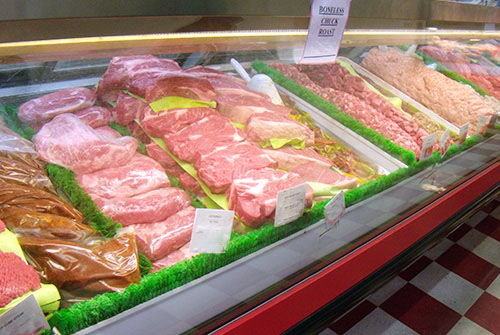Reveal the Art of the Butcher's Cut in a Modern Meat Market
In the ever-evolving landscape of modern meat markets, the butcher's cut has transcended its conventional roots, merging olden workmanship with modern methods. bagley farms meat market edwardsville il. Today's butchers are not simply processors of meat; they are educated craftsmens who stress sustainability and moral sourcing. Their proficiency in selecting and preparing cuts customized to particular culinary demands supplies an unparalleled eating experience. Yet, what absolutely establishes the modern butcher apart is their capacity to build a deeper link in between consumers and the origins of their meat. How do these masters equilibrium custom with innovation, and what effects does this have for the future of meat usage?
Evolution of Butchery Techniques

The mid-20th century saw butchery methods even more refined by scientific understandings right into muscle mass biology and meat aging, improving both tenderness and preference. Technologies like vacuum cleaner packaging and refrigeration extended item shelf-life, permitting butchers to branch out offerings and improve quality control. This duration additionally noted the increase of specialized tools, such as band saws and meat slicers, which boosted precision and efficiency in meat handling.
Computerized systems currently aid in monitoring pet provenance and enhancing cuts to fulfill certain customer choices. Additionally, a rebirth in artisanal butchery has arised, mixing conventional abilities with contemporary expertise to cater to customers seeking honest and lasting meat choices.

Comprehending Meat Cuts

Comprehending the ins and outs of meat cuts is essential for both butchers and consumers seeking high quality and worth. Each cut originates from a different part of the animal, imparting unique flavors, textures, and food preparation approaches. Mastery of these differences not just improves culinary experiences but additionally makes the most of the utility of each carcass. For butchers, specific cuts show skill and regard for the craft, making sure very little waste and optimal return.
The key groups of meat cuts consist of primal, sub-primal, and retail cuts. Butchers then damage these down even more right into sub-primal cuts, before ultimately creating retail cuts available to customers, like ribeye or tenderloin.
Comprehending muscular tissue structure is important; muscular tissues utilized extra often by the pet tend to be tougher important site and are best suited for slow-moving cooking approaches, while less-used muscles, like those found in the loin, are a lot more tender and suitable for cooking or roasting. Familiarity with these differences encourages customers to make informed choices, improving their cooking endeavors.
Choosing Top Quality Meat
Picking the right meat involves more than just selecting an aesthetically enticing item from the display screen. The art of picking top quality meat calls for a critical eye and expertise of certain qualities that symbolize quality and excellence. First of all, pay attention to the color; beef should have a bright, cherry-red tone, while lamb should show a soft pink tone, and pork a light pink. This shows the meat is fresh and hasn't been revealed to oxygen for as well long.
Secondly, consider the marbling, which describes the white flecks of fat within the muscular tissue. Appropriate marbling is an essential indication of tenderness and taste, as it melts throughout food preparation, enhancing the meat's juiciness. Keep in mind, higher marbling often navigate here associates with premium high quality cuts, such as USDA Prime.
Texture is one more crucial variable; meat ought to really feel firm to the touch, not slimed or overly soft. Furthermore, bear in mind the fragrance. Fresh meat should have a clean, neutral scent, without any kind of sour or off-putting smells.
Pairing Cuts With Food Preparation Methods
Efficiently matching cuts of meat with the proper cooking techniques is essential for accomplishing optimum flavor and structure. Various cuts differ in tenderness, marbling, and connective tissue web content, each requiring particular strategies to unlock their capacity. Tender cuts like filet mignon and ribeye, with their fundamental marbling, advantage from high-heat, quick-cooking approaches such as grilling or pan-searing. These techniques boost the meat's all-natural flavors and guarantee a juicy surface.
Conversely, tougher cuts like brisket and chuck roast are abundant in collagen, which damages down right into gelatin when cooked slowly. These cuts are suitable for braising or slow-moving roasting, permitting the meat to soften over time and develop deep, complicated flavors. Cuts such as short ribs and pork shoulder fare well with slow-cooking methods, where extended cooking times transform their durable appearances right into delicious meals.
Lamb shanks and oxtail, which need prolonged cooking to soften, are best prospects for stewing or slow simmering. These methods coax out abundant, passionate tastes while preserving moisture. By understanding the distinct qualities of each cut, chefs and home cooks alike can elevate their anchor cooking creations, making sure each meal is both pleasing and remarkable.
The Butcher's Function Today
Navigating the advancing landscape of the modern meat market, the butcher's duty today extends past mere preparation of cuts. Contemporary butchers are cooking artisans, instructors, and advocates for sustainable techniques.
Along with crafting specific cuts, butchers now involve straight with customers, supplying cooking guidance and customizing selections to fit individual requirements and preferences. Their knowledge in meat aging, marbling, and taste profiles encourages consumers to make educated decisions, improving their cooking experiences. This customized solution exhibits the butcher's developing duty as a trusted consultant in the cooking area.
Moreover, butchers are critical in decreasing waste, using entire animals to develop diverse items such as sausages and stocks - bagley farms meat market edwardsville il. This detailed strategy not only appreciates the pet but also lines up with contemporary sustainability objectives. In this means, the modern butcher symbolizes both tradition and development, adjusting to an ever-changing market while maintaining the virtuosity and integrity of their craft

Final Thought
Proficiency in comprehending diverse meat cuts and quality indications equips butchers to offer enlightened suggestions, straightening particular cuts with optimum cooking approaches. By honoring historic practices while welcoming contemporary needs, the butcher's role remains important in today's innovative meat market.